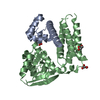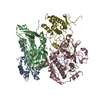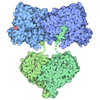+ Open data
Open data
- Basic information
Basic information
| Entry | Database: PDB / ID: 8bw9 | ||||||||||||
|---|---|---|---|---|---|---|---|---|---|---|---|---|---|
| Title | Cryo-EM structure of the RAF activating complex KSR-MEK-CNK-HYP | ||||||||||||
 Components Components |
| ||||||||||||
 Keywords Keywords | SIGNALING PROTEIN / Kinase suppressor of Ras (KSR) / Dual specificity mitogen-activated protein kinase kinase (MEK) / Connector enhancer of KSR (CNK) / Protein Aveugle (AVE) / Hyphen protein (HYP) / protein complex | ||||||||||||
| Function / homology |  Function and homology information Function and homology informationhemocyte differentiation / MAPK3 (ERK1) activation / MAPK1 (ERK2) activation / Frs2-mediated activation / Signal transduction by L1 / Negative feedback regulation of MAPK pathway / terminal region determination / RAF activation / Phosphorylation of CI / compound eye cone cell differentiation ...hemocyte differentiation / MAPK3 (ERK1) activation / MAPK1 (ERK2) activation / Frs2-mediated activation / Signal transduction by L1 / Negative feedback regulation of MAPK pathway / terminal region determination / RAF activation / Phosphorylation of CI / compound eye cone cell differentiation / Phosphorylation of SMO / terminal branching, open tracheal system / torso signaling pathway / photoreceptor cell development / tracheal outgrowth, open tracheal system / R7 cell fate commitment / compound eye photoreceptor cell differentiation / sevenless signaling pathway / Phosphorylation of PER and TIM / MAP2K and MAPK activation / eye photoreceptor cell differentiation / epithelial cell migration, open tracheal system / imaginal disc-derived wing vein specification / border follicle cell migration / imaginal disc-derived wing morphogenesis / anterior/posterior axis specification, embryo / cellular response to X-ray / mitogen-activated protein kinase kinase / MAP-kinase scaffold activity / mitogen-activated protein kinase kinase kinase binding / mitotic DNA replication checkpoint signaling / dorsal/ventral pattern formation / positive regulation of Ras protein signal transduction / mitotic G2 DNA damage checkpoint signaling / MAP kinase kinase activity / fibroblast growth factor receptor signaling pathway / vascular endothelial growth factor receptor signaling pathway / enzyme regulator activity / condensed chromosome / cell surface receptor protein tyrosine kinase signaling pathway / visual perception / ERK1 and ERK2 cascade / determination of adult lifespan / epidermal growth factor receptor signaling pathway / cytoplasmic side of plasma membrane / receptor tyrosine kinase binding / kinase binding / MAPK cascade / insulin receptor signaling pathway / apical part of cell / cell cortex / scaffold protein binding / protein tyrosine kinase activity / defense response to virus / Ras protein signal transduction / positive regulation of ERK1 and ERK2 cascade / non-specific serine/threonine protein kinase / protein kinase activity / protein phosphorylation / protein serine kinase activity / protein serine/threonine kinase activity / ATP binding / metal ion binding / plasma membrane / cytoplasm / cytosol Similarity search - Function | ||||||||||||
| Biological species |  | ||||||||||||
| Method | ELECTRON MICROSCOPY / single particle reconstruction / cryo EM / Resolution: 3.32 Å | ||||||||||||
 Authors Authors | Maisonneuve, P. / Fronzes, R. / Sicheri, F. | ||||||||||||
| Funding support |  Canada, Canada,  France, 3items France, 3items
| ||||||||||||
 Citation Citation |  Journal: Nat Struct Mol Biol / Year: 2024 Journal: Nat Struct Mol Biol / Year: 2024Title: The CNK-HYP scaffolding complex promotes RAF activation by enhancing KSR-MEK interaction. Authors: Pierre Maisonneuve / Malha Sahmi / Fanny Bergeron-Labrecque / Xianjie Iris Ma / Juliette Queguiner / Geneviève Arseneault / Martin Lefrançois / Igor Kurinov / Rémi Fronzes / Frank Sicheri / Marc Therrien /    Abstract: The RAS-MAPK pathway regulates cell proliferation, differentiation and survival, and its dysregulation is associated with cancer development. The pathway minimally comprises the small GTPase RAS and ...The RAS-MAPK pathway regulates cell proliferation, differentiation and survival, and its dysregulation is associated with cancer development. The pathway minimally comprises the small GTPase RAS and the kinases RAF, MEK and ERK. Activation of RAF by RAS is notoriously intricate and remains only partially understood. There are three RAF isoforms in mammals (ARAF, BRAF and CRAF) and two related pseudokinases (KSR1 and KSR2). RAS-mediated activation of RAF depends on an allosteric mechanism driven by the dimerization of its kinase domain. Recent work on human RAFs showed that MEK binding to KSR1 promotes KSR1-BRAF heterodimerization, which leads to the phosphorylation of free MEK molecules by BRAF. Similar findings were made with the single Drosophila RAF homolog. Here we show that the fly scaffold proteins CNK and HYP stabilize the KSR-MEK interaction, which in turn enhances RAF-KSR heterodimerization and RAF activation. The cryogenic electron microscopy structure of the minimal KSR-MEK-CNK-HYP complex reveals a ring-like arrangement of the CNK-HYP complex allowing CNK to simultaneously engage KSR and MEK, thus stabilizing the binary interaction. Together, these results illuminate how CNK contributes to RAF activation by stimulating the allosteric function of KSR and highlight the diversity of mechanisms impacting RAF dimerization as well as the regulatory potential of the KSR-MEK interaction. | ||||||||||||
| History |
|
- Structure visualization
Structure visualization
| Structure viewer | Molecule:  Molmil Molmil Jmol/JSmol Jmol/JSmol |
|---|
- Downloads & links
Downloads & links
- Download
Download
| PDBx/mmCIF format |  8bw9.cif.gz 8bw9.cif.gz | 223.3 KB | Display |  PDBx/mmCIF format PDBx/mmCIF format |
|---|---|---|---|---|
| PDB format |  pdb8bw9.ent.gz pdb8bw9.ent.gz | 145.8 KB | Display |  PDB format PDB format |
| PDBx/mmJSON format |  8bw9.json.gz 8bw9.json.gz | Tree view |  PDBx/mmJSON format PDBx/mmJSON format | |
| Others |  Other downloads Other downloads |
-Validation report
| Summary document |  8bw9_validation.pdf.gz 8bw9_validation.pdf.gz | 1.6 MB | Display |  wwPDB validaton report wwPDB validaton report |
|---|---|---|---|---|
| Full document |  8bw9_full_validation.pdf.gz 8bw9_full_validation.pdf.gz | 1.6 MB | Display | |
| Data in XML |  8bw9_validation.xml.gz 8bw9_validation.xml.gz | 38.1 KB | Display | |
| Data in CIF |  8bw9_validation.cif.gz 8bw9_validation.cif.gz | 53.8 KB | Display | |
| Arichive directory |  https://data.pdbj.org/pub/pdb/validation_reports/bw/8bw9 https://data.pdbj.org/pub/pdb/validation_reports/bw/8bw9 ftp://data.pdbj.org/pub/pdb/validation_reports/bw/8bw9 ftp://data.pdbj.org/pub/pdb/validation_reports/bw/8bw9 | HTTPS FTP |
-Related structure data
| Related structure data |  16281MC  8bw8C M: map data used to model this data C: citing same article ( |
|---|---|
| Similar structure data | Similarity search - Function & homology  F&H Search F&H Search |
- Links
Links
- Assembly
Assembly
| Deposited unit | 
|
|---|---|
| 1 |
|
- Components
Components
-Protein , 4 types, 4 molecules ABCD
| #1: Protein | Mass: 13143.911 Da / Num. of mol.: 1 Source method: isolated from a genetically manipulated source Source: (gene. exp.)   |
|---|---|
| #2: Protein | Mass: 38534.203 Da / Num. of mol.: 1 Source method: isolated from a genetically manipulated source Source: (gene. exp.)  Gene: cnk, anon-WO0140519.129, anon-WO0257455.27, CNK, Cnk, Dmel\CG6556, EC2-3, EK2-3, l(2)k16314, sag, CG6556, Dmel_CG6556 Production host:  |
| #3: Protein | Mass: 43926.496 Da / Num. of mol.: 1 Source method: isolated from a genetically manipulated source Source: (gene. exp.)   References: UniProt: Q24324, mitogen-activated protein kinase kinase |
| #4: Protein | Mass: 36474.898 Da / Num. of mol.: 1 Source method: isolated from a genetically manipulated source Source: (gene. exp.)   |
-Non-polymers , 3 types, 3 molecules 




| #5: Chemical | ChemComp-ANP / |
|---|---|
| #6: Chemical | ChemComp-QOM / |
| #7: Chemical | ChemComp-MG / |
-Details
| Has ligand of interest | Y |
|---|
-Experimental details
-Experiment
| Experiment | Method: ELECTRON MICROSCOPY |
|---|---|
| EM experiment | Aggregation state: PARTICLE / 3D reconstruction method: single particle reconstruction |
- Sample preparation
Sample preparation
| Component | Name: Quaternary complex of the kinase domains of KSR and MEK bound to the scaffolding complex CNK-HYP Type: COMPLEX / Details: Mg2+/ANP and Trametinib ligands bound to MEK / Entity ID: #1-#4 / Source: RECOMBINANT | |||||||||||||||||||||||||
|---|---|---|---|---|---|---|---|---|---|---|---|---|---|---|---|---|---|---|---|---|---|---|---|---|---|---|
| Molecular weight | Value: 0.132 MDa / Experimental value: NO | |||||||||||||||||||||||||
| Source (natural) | Organism:  | |||||||||||||||||||||||||
| Source (recombinant) | Organism:  | |||||||||||||||||||||||||
| Buffer solution | pH: 7 / Details: AMPPNP 25mM Trametinib 0.05mM | |||||||||||||||||||||||||
| Buffer component |
| |||||||||||||||||||||||||
| Specimen | Conc.: 0.79 mg/ml / Embedding applied: NO / Shadowing applied: NO / Staining applied: NO / Vitrification applied: YES | |||||||||||||||||||||||||
| Specimen support | Grid material: COPPER / Grid mesh size: 200 divisions/in. / Grid type: Quantifoil R2/2 | |||||||||||||||||||||||||
| Vitrification | Instrument: FEI VITROBOT MARK IV / Cryogen name: ETHANE / Humidity: 100 % / Chamber temperature: 277.15 K / Details: 3.5 sec blot time 1 sec drain time |
- Electron microscopy imaging
Electron microscopy imaging
| Experimental equipment |  Model: Talos Arctica / Image courtesy: FEI Company |
|---|---|
| Microscopy | Model: FEI TALOS ARCTICA |
| Electron gun | Electron source:  FIELD EMISSION GUN / Accelerating voltage: 200 kV / Illumination mode: FLOOD BEAM FIELD EMISSION GUN / Accelerating voltage: 200 kV / Illumination mode: FLOOD BEAM |
| Electron lens | Mode: BRIGHT FIELD / Nominal defocus max: 26398 nm / Nominal defocus min: 5212 nm |
| Image recording | Electron dose: 1.15 e/Å2 / Detector mode: COUNTING / Film or detector model: GATAN K2 SUMMIT (4k x 4k) / Num. of real images: 44 |
- Processing
Processing
| Software |
| ||||||||||||||||||||||||
|---|---|---|---|---|---|---|---|---|---|---|---|---|---|---|---|---|---|---|---|---|---|---|---|---|---|
| EM software |
| ||||||||||||||||||||||||
| CTF correction | Type: PHASE FLIPPING AND AMPLITUDE CORRECTION | ||||||||||||||||||||||||
| Symmetry | Point symmetry: C1 (asymmetric) | ||||||||||||||||||||||||
| 3D reconstruction | Resolution: 3.32 Å / Resolution method: FSC 0.143 CUT-OFF / Num. of particles: 141531 / Symmetry type: POINT | ||||||||||||||||||||||||
| Refinement | Cross valid method: NONE Stereochemistry target values: GeoStd + Monomer Library + CDL v1.2 | ||||||||||||||||||||||||
| Displacement parameters | Biso mean: 119.78 Å2 | ||||||||||||||||||||||||
| Refine LS restraints |
|
 Movie
Movie Controller
Controller



 PDBj
PDBj




















